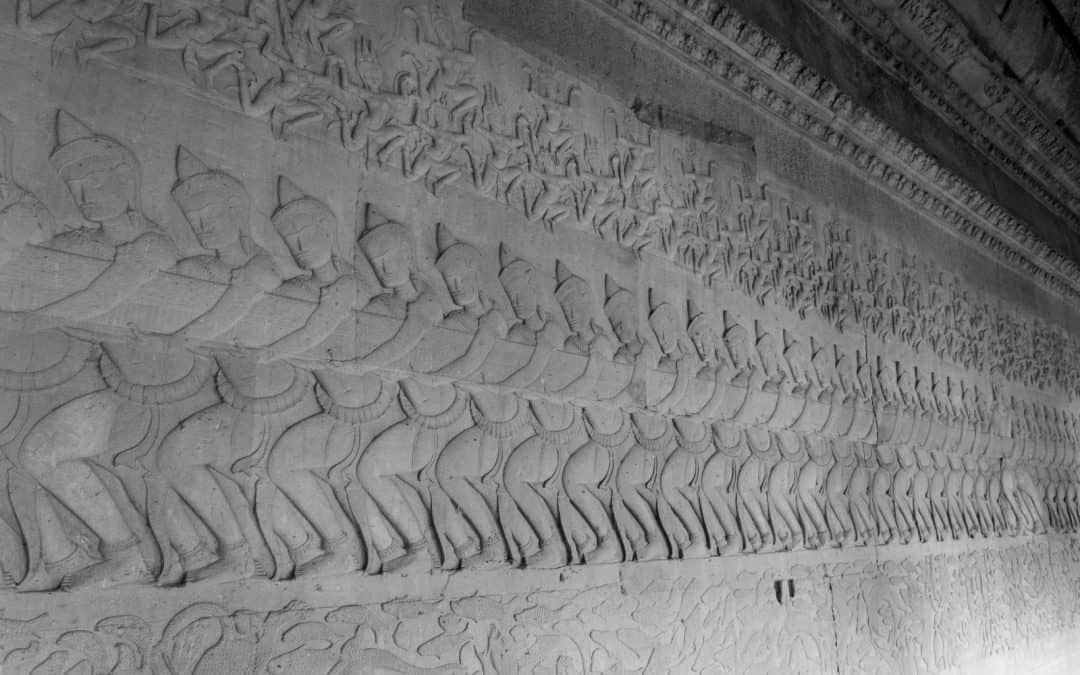Angkor Wat, an architectural wonder standing majestically in the heart of Cambodia, is a beacon of Khmer Empire’s illustrious heritage.
Distinguished as the largest religious monument in the world, this enigmatic temple complex does not merely reflect the empire’s advanced engineering prowess and artistic finesse, but also offers a deep insight into their religious and cultural tapestry.
I’m going to explain the significance of Angkor Wat, unraveling its role as a symbol of Khmer Empire’s power, an epitome of brilliant engineering and supreme artistry, a cornerstone of evolving religious practices, a reflection of religious devotion, and an enduring source of Khmer national pride and heritage.
Key Takeaways
- Symbol of Khmer Empire’s power and dominance in Southeast Asia
- Showcase of advanced engineering and artistry
- Role in religious and cultural practices
- Reflection of devotion to Hinduism and Buddhism
Symbol of Khmer Empire’s Power
Angkor Wat served as a tangible manifestation of the Khmer Empire’s power and dominance in Southeast Asia.
This architectural marvel not only showcased the empire’s impressive engineering skills, but also its cultural influence on the region.
As the largest religious monument in the world, Angkor Wat demonstrated the Khmer Empire’s ability to undertake grand construction projects and their mastery of architectural techniques.
The sheer size and complexity of Angkor Wat showcased the empire’s wealth and resources. Its intricate carvings and detailed bas-reliefs depicted scenes from Hindu mythology, reflecting the empire’s religious beliefs and cultural values.
These carvings also served as historical records, providing insight into the Khmer Empire’s history and achievements.
Furthermore, the strategic location of Angkor Wat, situated at the heart of the empire, symbolized the empire’s political power and control over its territories.
The temple complex wasn’t only a place of worship, but also a center for administration and governance.
Showcasing Advanced Engineering and Artistry
If you really want to grasp how much Angkor Wat means to the Khmer people, you need to take a moment to be awed by the meticulous handiwork and clever construction methods evident in every corner of this extraordinary place.
Angkor Wat isn’t only an architectural marvel but also a testament to the advanced skills and ingenuity of the Khmer civilization.
The temple complex showcases the Khmer’s ability to create grand structures that blended artistry with functionality.
One of the most impressive aspects of Angkor Wat is its innovative engineering techniques.
The temple was built using a combination of sandstone blocks and laterite, a type of durable rock.
The Khmer engineers employed a system of interlocking stones, without the use of mortar, to create the massive structures that still stand today.
This technique allowed for flexibility and stability, ensuring the longevity of the temple complex.
In addition to its engineering feats, Angkor Wat also showcases the Khmer’s mastery of craftsmanship.
The intricate carvings and bas-reliefs that adorn the walls of the temple are a testament to the artistic talent of the Khmer people.
These carvings depict scenes from Hindu mythology, as well as everyday life during the Khmer Empire.
The level of detail and precision in these carvings is truly awe-inspiring and demonstrates the Khmer’s dedication to creating works of art.
Role in Religious and Cultural Practices
As you learn more about the importance of Angkor Wat to the Khmer civilization, it becomes clear that this extraordinary structure was central to their religious and cultural life.
The influence of Angkor Wat on architecture can’t be overstated.
It served as a model for subsequent Khmer temples and influenced the architectural style of the region for centuries.
The temple’s unique blend of Hindu and Buddhist elements showcased the religious syncretism of the Khmer people, who embraced both religions.
The intricate carvings and sculptures adorning the walls of Angkor Wat depicted scenes from Hindu epics and Buddhist legends, providing a visual representation of the Khmer’s religious beliefs.
Angkor Wat’s significance extended beyond religious practices. Its grandeur and magnificence made it a symbol of Khmer power and identity.
The temple served as a focal point for important religious ceremonies, including coronations and state rituals, further solidifying its cultural importance.
Angkor Wat’s architectural brilliance and historical significance have made it a major tourist attraction.
Its impact on tourism can’t be underestimated, as it draws millions of visitors each year, contributing to the economic development of the region and promoting cultural exchange.
Reflection of Devotion to Hinduism and Buddhism
By showcasing intricate carvings and sculptures depicting scenes from Hindu epics and Buddhist legends, Angkor Wat reflects the Khmer people’s deep devotion to both Hinduism and Buddhism.
This grand temple complex, built in the 12th century, stands as a testament to the Khmer Empire’s religious syncretism and architectural marvels.
Angkor Wat was originally constructed as a Hindu temple, dedicated to the god Vishnu.
The elaborate bas-reliefs that adorn its walls depict tales from the Hindu epics of the Ramayana and the Mahabharata.
These intricate carvings not only showcase the Khmer people’s artistic prowess but also serve as a visual representation of their devotion to Hinduism.
However, over time, Angkor Wat became a symbol of the Khmer Empire’s religious and cultural evolution, as it gradually transformed into a Buddhist temple.
The shift from Hinduism to Buddhism is evident in the later additions to the complex, such as the statue of Buddha and the Buddhist stupas that were added to the site.
This syncretism between Hinduism and Buddhism is a reflection of the Khmer people’s openness to new ideas and their ability to adapt and incorporate different religious beliefs.
It also demonstrates their desire to create a harmonious blend of both faiths, allowing for a unique religious and cultural expression.
Source of National Pride and Heritage
Angkor Wat continues to be a source of national pride and heritage for the Khmer people due to its historical and cultural significance.
It isn’t only a symbol of their national identity but also an architectural marvel that showcases the grandeur and skill of their ancestors.
The Khmer people take great pride in Angkor Wat because it represents their rich historical heritage.
Built in the early 12th century, it was the capital of the Khmer Empire and the largest religious monument in the world.
Its construction was a testament to the power and sophistication of the Khmer civilization, which once ruled over a vast empire in Southeast Asia.
Angkor Wat also holds immense cultural significance for the Khmer people.
It’s a sacred site for both Hinduism and Buddhism, reflecting the religious diversity and tolerance of the Khmer Empire.
The intricate carvings and bas-reliefs depict scenes from Hindu epics like the Ramayana and Mahabharata, as well as Buddhist stories.
These artistic representations not only showcase the religious beliefs of the Khmer people but also serve as a historical record of their culture.
Conclusion
Angkor Wat encapsulates the essence of the Khmer Empire’s strength, architectural genius, cultural richness, and spiritual devotion.
With its intricate carvings echoing tales from Hindu epics and Buddhist legends, its towering structures defying time through innovative engineering techniques, and its pivotal position in the religious and administrative practices, Angkor Wat is an enduring testament to the grandeur of the Khmer civilization.
Its significance, deeply embedded in the Khmer identity, makes it not just a major tourist attraction, but a source of immense national pride and a treasure trove of historical insights.
The story of Angkor Wat, firmly rooted in its stone walls, invites us to marvel at an empire that once was, and continues to inspire awe, respect, and curiosity in the hearts of millions.



